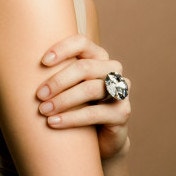Who Invented Engagement Rings, Anyway?
A short history of how the diamond engagement ring came to prominence.

Have you ever wondered why we first began lusting after diamonds? Blame it on one enterprising archduke, who arguably started the tradition.
One of the first recorded uses of a diamond engagement ring was Archduke Maximilian of Austria's proposal to Mary of Burgundy with a ring set with thin, flat pieces of diamonds in the shape of an "M."
But we can trace this mark-your-territory wedding trend way, way back, eons before Max and his fair Lady M.
Below, how our love affair with the rock slowly evolved.
Pre-History: The caveman tied cords made of braided grass around his chosen mate’s wrists, ankles, and waist, to bring her spirit under his control.
CIRCA 2800 BC: Egyptians are buried wearing rings made of a single silver or gold wire on the third finger of their left hands, believed to be connected directly to the heart by the vena amoris.
2ND CENTURY BC: According to Pliny the Elder, the groom gives the bride first a gold ring to wear during the ceremony and at special events, then an iron ring to wear at home, signifying her binding legal agreement to his ownership of her.
1ST CENTURY BC: Puzzle rings first appear in Asia, where sultans and sheiks use them to tag each of their wives.
1217: The bishop of Salisbury puts an end to the popular practice of seducing girls into mock marriage with rings made of rushes. His solution? Declaring a marriage with a rush-ring legally binding.
1456: The Gutenberg bible is published. There is no mention of betrothal or marriage rings in this or any other edition of the bible.
More Related Content From Your Tango:
- 5 Weird and Notable Engagement Rings
- How To End An Engagement
- 9 Signs You Should Make Him Engagement Chicken
1477: In one of the first recorded uses of a diamond engagement ring, Archduke Maximilian of Austria proposes to Mary of Burgundy with a ring that is set with thin, flat pieces of diamonds in the shape of an "M."
1700s: Silver "poesy rings" engraved with flowery sayings are in vogue in Europe. Across the Atlantic Ocean, the Puritans give their betrotheds useful thimbles instead of rings, which are derided as frippery. Eventually, however, many thimbles get their tops sliced off and are worn as rings anyway.
1800s: The highly sentimental Victorians make jewelry from human hair, and use gemstones to spell out names or endearments, such as a D-E-A-R-E-S-T ring set with a sequence of diamond, emerald, amethyst, ruby, emerald, etc.
1867: Diamonds are discovered in the Cape Colony (now a province in South Africa), the beginning of a huge increase in the diamond supply.
1880: Cecil Rhodes, who arrived in South Africa in 1873, founds the DeBeers Mining Company with other investors. Within the decade, they will control 90 percent of the world’s diamond production.
1886: Tiffany & Co. introduces the "Tiffany setting," a six-prong ring designed to maximize a diamond's brilliance by raising it up from the band.
1890s: Affordable wedding rings and diamond engagement rings appear in mail-order catalogs, such as Sears & Roebuck.
1918: Cartier creates the Trinity Ring—intertwined hoops in pink gold (love), white gold (friendship), and yellow gold (fidelity)—for Jean Cocteau, who gives one to his lover, poet Raymond Radiguet. It is still a traditional wedding ring in France.
1920s: Manufacturers and retail jewelers try to launch the concept of men's engagement rings, which sinks like a lead balloon.
Early 1940's: Engagement rings become the leading line of jewelry in most department stores.
1944: A Catholic priest queries The American Ecclesiastical Review as to whether he's permitted to marry a couple in a "double ring" ceremony, and, if so, how to go about it. (The Roman Ritual calls only for the blessing of the bride's ring.) The Review OKs the practice.
1946: Humphrey Bogart chooses to wear his first groom's ring when he is married—for the fifth, and final, time—to Lauren Bacall.
1950: Breakfast at Tiffany's is published. In Truman Capote’s novel, Tiffany's engraves the cracker-jack ring that winds up as Holly Golightly's engagement ring.
1978: Following her divorce from Richard Burton, Liz Taylor puts the 69-plus karat "Taylor-Burton" diamond up for sale to raise funds for a hospital in Botswana.
2000: Amid growing concern over human rights violations associated with their trade, the diamond industry creates the World Diamond Council to develop and oversee a tracking system that will "prevent the exploitation of diamonds for illicit purposes such as war and inhumane acts."
2001: Brad Pitt sues Dalmani International, which made the wedding ring he gave Jennifer Aniston. Pitt says the ring was his exclusive design, but the company sold replicas and implied the couple endorsed them.
2002: According to a Fairchild Bridal Group Study, more than a third of couples buying diamond engagement rings spend at least two months' salary.
2003: Wal-Mart introduces its "Keepsake" brand of diamonds and, according to its annual report, becomes "one of the top sellers of diamonds in the world."
2005: A week before Valentine's Day, the one-carat round solitaire diamond ring set in 14K white gold ($1,988) is out of stock on Wal-Mart.com. The author of this story notices a day-glo billboard in her hometown of Lincoln, Nebraska, advertising an "ENGAGEMENT RING EXPLOSION," and hopes no one was hurt.
